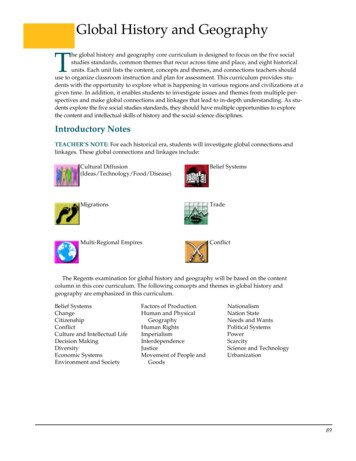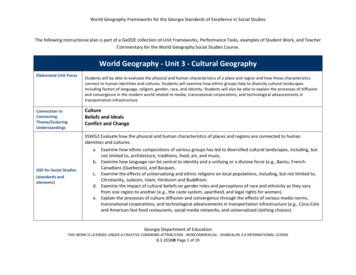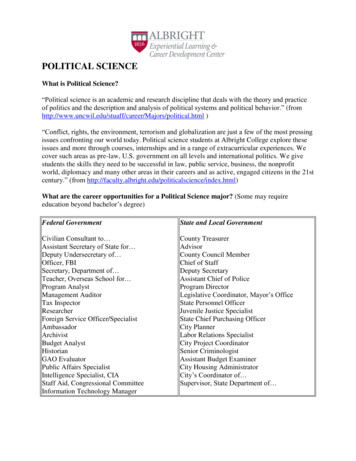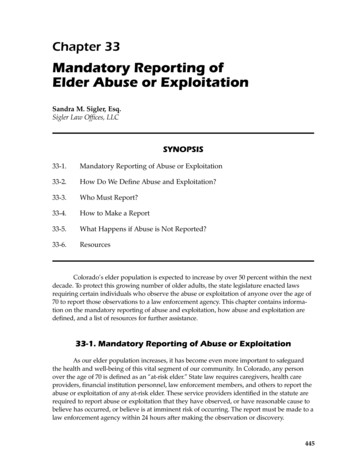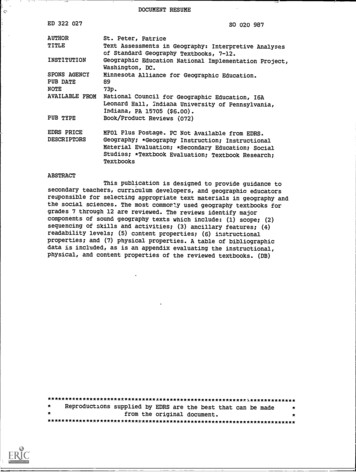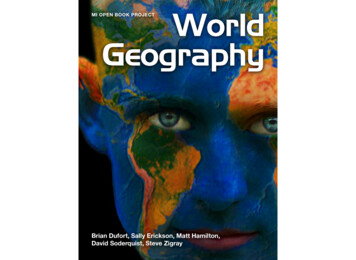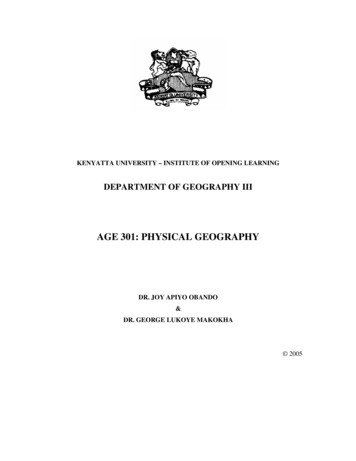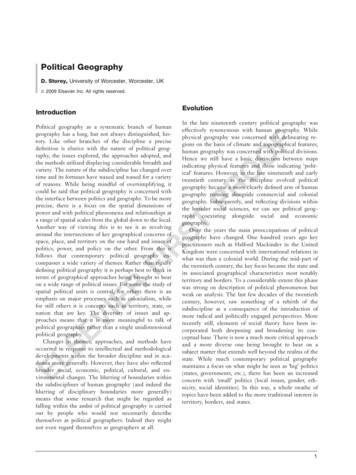
Transcription
Political GeographyD. Storey, University of Worcester, Worcester, UK& 2009 Elsevier Inc. All rights reserved.EvolutionOOFIn the late nineteenth century political geography waseffectively synonymous with human geography. Whilephysical geography was concerned with delineating regions on the basis of climate and topographical features,human geography was concerned with political divisions.Hence we still have a basic distinction between mapsindicating physical features and those indicating ‘political’ features. However, in the late nineteenth and earlytwentieth century as the discipline evolved politicalgeography became a more clearly defined arm of humangeography running alongside commercial and colonialgeography. Subsequently, and reflecting divisions withinthe broader social sciences, we can see political geography coexisting alongside social and economicgeography.Over the years the main preoccupations of politicalgeography have changed. One hundred years ago keypractitioners such as Halford Mackinder in the UnitedKingdom were concerned with international relations inwhat was then a colonial world. During the mid-part ofthe twentieth century, the key focus became the state andits associated geographical characteristics most notablyterritory and borders. To a considerable extent this phasewas strong on description of political phenomenon butweak on analysis. The last few decades of the twentiethcentury, however, saw something of a rebirth of thesubdiscipline as a consequence of the introduction ofmore radical and politically engaged perspectives. Morerecently still, elements of social theory have been incorporated both deepening and broadening its conceptual base. There is now a much more critical approachand a more diverse one being brought to bear on asubject matter that extends well beyond the realms of thestate. While much contemporary political geographymaintains a focus on what might be seen as ‘big’ politics(states, governments, etc.), there has been an increasedconcern with ‘small’ politics (local issues, gender, ethnicity, social identities). In this way, a whole swathe oftopics have been added to the more traditional interest interritory, borders, and states.ELSEVIERFIRSTPolitical geography as a systematic branch of humangeography has a long, but not always distinguished, history. Like other branches of the discipline a precisedefinition is elusive with the nature of political geography, the issues explored, the approaches adopted, andthe methods utilized displaying considerable breadth andvariety. The nature of the subdiscipline has changed overtime and its fortunes have waxed and waned for a varietyof reasons. While being mindful of oversimplifying, itcould be said that political geography is concerned withthe interface between politics and geography. To be moreprecise, there is a focus on the spatial dimensions ofpower and with political phenomena and relationships ata range of spatial scales from the global down to the local.Another way of viewing this is to see it as revolvingaround the intersections of key geographical concerns ofspace, place, and territory on the one hand and issues ofpolitics, power, and policy on the other. From this itfollows that contemporary political geography encompasses a wide variety of themes. Rather than rigidlydefining political geography it is perhaps best to think interms of geographical approaches being brought to bearon a wide range of political issues. For some the study ofspatial political units is central, for others there is anemphasis on major processes such as colonialism, whilefor still others it is concepts such as territory, state, ornation that are key. The diversity of issues and approaches means that it is more meaningful to talk ofpolitical geographies rather than a single unidimensionalpolitical geography.Changes in themes, approaches, and methods haveoccurred in response to intellectual and methodologicaldevelopments within the broader discipline and in academia more generally. However, they have also reflectedbroader social, economic, political, cultural, and environmental changes. The blurring of boundaries withinthe subdisciplines of human geography (and indeed theblurring of disciplinary boundaries more generally)means that some research that might be regarded asfalling within the ambit of political geography is carriedout by people who would not necessarily describethemselves as political geographers. Indeed they mightnot even regard themselves as geographers at all.PRIntroduction1
Political GeographyELSEVIERFIRFOSTThe German geographer Friedrich Ratzel has been attributed with the first major work to include politicalgeography in its title – Politische geographie, published in1897. Ratzel likened the state to an organism whichneeded further space or lebensraum in order to expand.This organic theory of the state could be said to reflecttwo main characteristics of much late-nineteenth-century and early-twentieth-century political geography.First, it employed ideas derived from biology and otherphysical sciences and applied these to politics and society. Second, it reflected the view of Ratzel and others thatgeography and other branches of academia should be putinto the service of the state. Ratzel was a supporter ofGerman imperialism and his theories and his politicswent hand-in-hand.In the UK perhaps the most famous political geographer of the era was Halford Mackinder. He has beencredited with attempting to shape the nature of geography in Britain in the early twentieth century and argued that the discipline should have objectives whichwere not just academic and educational but which shouldalso serve the needs of politicians and business people.This vision of geography was a reflection of his ownpolitical views and he was at one time an MP and servedas a British government advisor at the Versailles conference at the end of World War I. Mackinder is most remembered for his heartland theory or geographical pivotof history in which he suggested that, while sea powerhad served Britain well, technological changes, mostnotably the expansion of railways, meant that controlover major land masses was of crucial importance. Heargued the Eurasian landmass (essentially Russia) was ofcrucial significance and containing Russian expansionwas of the utmost importance for Britain in its wish tomaintain political prominence. Mackinder, like Ratzel,wrote from what can be seen as an imperial point of view.For all these ‘imperial’ political geographers their ideaswere bound up with the influence of both physical features, such as mountains and rivers, and human geographical considerations on politics and their role inaffecting the strategies of states. Their task, as they saw it,was the devising of practical geostrategies which could beutilized by political leaders.Like his European counterparts, the US geographerIsaiah Bowman was an adviser to the government. Following World War I, he played a role in the redrawing ofEuropean borders in his capacity as a member of the USdelegation at Versailles. While Bowman tended to see hiscontributions as detached and objective, his view of theworld was mediated through the lens of US geostrategicinterests. With his anticommunist views he endeavored tofashion a political geography reflective of US interests. Atabout the same time the German geographer KarlHaushofer utilized and developed Ratzel’s ideas of lebensraum. Hitler’s subsequent use of the concept as justification for German territorial expansion meant thatboth Haushofer and his ideas were heavily criticized. Thesubsequent significant decline of geopolitics has been atleast partly attributable to this tainted episode in itshistory.In the 1930s and 1940s the American geographerRichard Hartshorne attempted to delineate the field ofgeography. More specifically he also sought to outline thesphere of political geography as a subdiscipline. He sawpolitical areas, most obviously the state, as a centralconcern, which dovetailed with his broader view ofgeography as an idiographic discipline in which the region was the central object of study. The discrediting ofgeopolitics and the retreat of geography into a largelydescriptive regionalizing phase meant that for much ofthe mid-part of the twentieth century political geographybecame preoccupied with the study of states and theirborders. Issues of natural and artificial borders and theories of state evolution which likened these human creations to ‘natural’ phenomena were devised. While itwould be simplistic to dismiss all of the work produced atthis time, it has been seen as largely descriptive andpolitically conservative in its ‘naturalizing’ of the role ofthe state.Recent decades have seen a significant rebirth ofpolitical geography stimulated by a number of methodological and theoretical developments. The dawn of amore quantitative approach in the 1960s saw politicalgeographers work much more extensively with largevolumes of data. This is most obviously reflected in thedevelopment of an electoral geography which cast lighton such things as the importance of place and locality invoting patterns and the intersections of national issueswith more local concerns. In exploring voting patternsattention was drawn to the ways in which neighborhoodeffects cross-cut broader political issues to produceparticular spatial patterns.Geography’s radical revolution brought about two keypolitical geographic changes. Firstly it saw the introduction of more overtly structuralist perspectives intopolitical geography and secondly it resulted in a verypoliticized geography. In the first instance a range ofhuman geographical phenomena were analyzed within abroader framework. The impact of overarching social,economic, and political processes on people and placeswas emphasized. An example of this is the application ofWallerstein’s world systems theory in the work of PeterTaylor. Here, rather than seeing states in isolation, thereis an emphasis on the complexities of an interstate systemand the connections between long-term cycles of economic change and state stability and state structure.The radical revolution within geography saw an intense politicization of the discipline. The 1960s saw theOIdeas and DevelopmentsPR2
Political Geographyand citizenship. IdentityElectoralgeography. Environment. OFThese themes are not discrete and they cross-cut themore general geographic themes of space and place. Asnoted earlier the themes examined and the approachesadopted owe a lot to shifting paradigms within thebroader discipline. The regionalist, empiricist, structuralist, and postmodern perspectives in particular are allapparent within the work produced within the past 50 orso years. By the same token, the scales of analyses havevaried from the global through the national and regionaldown to the local. More recently, the interconnectionsbetween different scales of analysis have been emphasized. The local impacts of more national or globalpolitical processes or policies are one example.OTerritory and TerritorialityPRTerritory refers to a bounded geographic space withterritoriality referring to the attempts to control thatspace. Traditionally ‘formal’ political territories (mostobviously states) were the main concern of politicalgeographers but more recently territory at a more informal level has come in for scrutiny. Thus, we can thinknot only of territory defined by the borders betweencountries but also reflected in everyday life when we areconfronted with signs saying ‘authorized personnel only’,‘keep out’, ‘no tresspassing’, ‘strictly no admittance’, andso on. The idea of the home as private space and territorial divisions in the home based on divisions betweenadult and child space or on gendered divisions of laborare examples of more micro-scale territoriality.Some strands of thought have ‘naturalized’ territorialbehavior as something innate in humans. In this view theclaiming of geographic space is seen as natural anddefense of territory is seen as a biological urge. Othershave viewed this in more social terms and, utilizing theideas of Robert Sack, have seen territory as a key organizing device and territorial behavior as a means ofretaining or resisting political power. From a politicalgeographic perspective, territorial behavior might beviewed as a geographic and political strategy designed toachieve particular ends. In this way, the control of geographic space can be used to assert or to maintain power,or to resist the power of a dominant group. It followsfrom this that territories, whether, states, regions, counties, workplaces, the home, are not natural entities butthe outcomes of a variety of social practices and processesin which space and society are linked. It is easy to regardterritories as spatial containers but they are much morethan that. They serve to convey messages of authority,power, and control. Issues of territory and territorialityare seen to be key underpinnings for many politicalgeographic issues.ELSEVIERFIRSTpromulgation of the idea that everything is political andhence all areas of geographic inquiry were infused withpolitical connotations. Radical geographers began askingintensely political questions about the distribution ofwealth and power, control over resources, issues of discrimination, development and so on, while advocatingradical political change in order to eradicate inequality inits various guises. Territorial social justice became a keyconcern, while the idea of academic objectivity andneutrality was eschewed in favor of a politically committed geography designed to radically transform theunjust structures which resulted in gross inequities. Thisdevelopment reflected broader social and political turmoil in an era of US involvement in Vietnam, strugglesagainst racism in various parts of the world, and thegrowth of the women’s movement and environmentalconcerns. The resurgence of interest in political geography and the emergence of politicized geographers werereflected in the launch of the journal Political GeographyQuarterly in 1982. This has subsequently increased itsannual output and is now known simply as PoliticalGeography.More recently the influence of social theory in itsbroadest sense can be detected in some branches of research. Some geographers have explored aspects ofeveryday life and the ways in which political processesimpact on people and inform their sense of identity. It isclear that politics affects us all in a myriad of ways. Whileolder political geographies tended to focus on the worldof formal politics and happenings in the ‘corridors ofpower’, more recent versions explore the everyday consequences of power and challenges to it. There has been agrowing emphasis on the politics of identity, whetherframed in terms of nationality, gender, ethnicity, sexuality, or other divisions. Alongside this, and closely connected to it, a postmodern influence has focusedattention on the discourses employed by different groupsin relation to political space. There is an emphasis ondiversity and allowing different voices to be heard. Thishas helped bolster earlier concerns with those at thereceiving end of unequal power relationships. Similarly,using the ideas of Foucault and others, there have beenexplorations of the ways in which power operates anddiffuses across geographic scales.Major ThemesWhile political geography now embraces a wide range ofconcerns some core themes can be identified. Chiefamong these are:and territoriality. TerritoryState. Geopolitics. Nation. 3
Political GeographyFStateOThe division of the world into bounded political units,commonly referred to as states, is the best-known example of formalized territories and of political–territorialorganization. As a consequence, the state has long been acentral element in political geography with a focus onvarious facets of the state including their origins, spatialdevelopment, key properties, roles, and functions. Traditional approaches in political geography have tended totake the state for granted. However, while it may be thedominant form of political territorial organization in thecontemporary world, it has not always been so. Nevertheless, the state has been naturalized in much politicalgeography. Geographers such as Ratzel developed ‘organic’ theories of the state which likened it to a naturalentity which needed living space. Others devised theoriesof state growth in which it was argued states evolvedthrough phases from youth to maturity, similar to rivers.These ideas can be seen as part of the broader trend ofdevising theories of political behavior analogous to natural processes. Ideas of state stability or instability wereoften linked to state size in terms of either land area orpopulation and the extent of internal regional differences, whether physical, economic, or cultural. Thesecentrifugal or centripetal pressures would help to determine state stability or instability.Conflicts between states, especially border disputes,have also been a focus of attention. While earlier consideration of borders tended to explore distinctions between natural boundaries (such as rivers) and artificialboundaries (lines of latitude or longitude, for example),more recent perspectives have broadened to examineborders, not just as lines dividing territories, but as socialand discursive constructs which can have importantramifications in people’s everyday lives. They may have aprofound impact on people’s ability to travel and on awhole range of ‘ordinary’ activities. For some, such asnomadic groups, borders may be irritants that disrupttheir social practices. Some borders are more significantthan others; the French–Spanish border is less significantELSEVIERFIRSTGeopolitics is sometimes defined as the geographicaldimensions of power (and hence seen as synonymouswith political geography). It has tended to be concernedwith international relations and in particular with thegeostrategic concerns of major powers. The work ofRatzel and Mackinder are early examples of geopoliticalwriting with an emphasis on the geographic bases ofpolitical strategy. Different geopolitical eras can beidentified characterized by changes in hegemonic powerfrom the colonial era dominance of the likes of Britainand France, through the USA–USSR rivalry of the ColdWar, to the current military dominance of the UnitedStates. As well as examining the geopolitical strategies ofstates and political leaders, geographers have pointed tothe role of maps and mapping, together with ideas ofenvironmental determinism (closely linked to scientificracism) as mechanisms through which colonialism wasfacilitated and justified. Within the Cold War there areclearly demonstrable geostrategic elements within USthinking. These included the invoking of the MonroeDoctrine (with the Americas as the US sphere of influence), the propounding of domino theory (that once onecountry fell to communism others would follow), andterritorial strategies of containment (prevention of communism spreading beyond its existing ‘borders’).Much traditional geopolitical writing tended not justto be written from the perspective of a particular geographical and ideological standpoint but also from anassumption of inevitability. The development of a morecritical geopolitics through the work of people likeGearóid Ó Tuathail and Simon Dalby has created a morepolitically challenging perspective on global politicalissues. Here the emphasis on realpolitik is challenged by aview which refuses to accept the inevitability of currentpower relations and which affords the possibility (anddesirability) of radical change. A strand of this is exploring the geopolitical discourses used by governmentsand political leaders. The ways in which places and regions are reduced to their strategic significance withinglobal power politics is reflected through the use ofparticular terminology. For example in the 1980s formerUS President Ronald Reagan referred to the then USSRas an ‘evil empire’. In a similar vein, the current Bushadministration in the US conjured up an ‘axis of evil’.These constructions and others such as some Islamicfundamentalist characterizations of a ‘decadent’ West canbe read as geopolitical discourses designed to frameevents in particular ways. The current ‘New WorldOrder’ has been viewed in various ways ranging fromSamuel Huntingdon’s famous (and somewhat reductionist) exposition of a ‘clash of civilizations’ to DavidHarvey’s political-economy perspective in which currentUS geopolitical strategy is seen to be driven by territorialand capitalist imperatives and closely linked to resourcecontrol.As well as the more obvious discourses emanatingfrom politicians, geopolitical discourse has also beenexplored through film and other media. The ways inwhich events such as the Vietnam War have been framedby filmmakers or the worldview refracted through publications such as Reader’s Digest are examples of the waysin which people, places, and events are represented andthrough which particular ideologies (often using simplistic representations of ‘good guys’ and ‘bad guys’ andparticular constructions of concepts such as ‘freedom’)are disseminated and reproduced.OGeopoliticsPR4
Political GeographyPROOFthe end of the state as a meaningful political entity as aworld of demarcated political spaces is replaced by increased flows of capital, labor, information, etc. It issuggested that the state’s role as the sovereign authorityover its own territory is much diminished. Contemporarypolitical trends have focused attention on the ways inwhich sovereignty is asserted and contested whetherthrough global processes, secessionist nationalism orsuprastate institutions such as the EU leading some topredict the end of the state as a viable political–territorialentity. However, others argue that, far from disappearing,the state will continue to play a key role. At the time ofwriting, the US (a state) has recently invaded Afghanistan, Iraq and, appears to be contemplating the invasionof another, Iran, with a view to reshaping these in a waythat suits its geopolitical ambitions. This hardly signalsthe demise of the state as a territorial phenomenon.Recent decades have also seen the ‘rolling back’ of thestate in many countries as public services have been increasingly privatized. In countries such as the UnitedKingdom, this has been accompanied by an emphasis onpartnership arrangements between various statutory andnonstatutory bodies, alongside an apparent attempt toinvolve community groups in decision making. This reflects what some see as the fragmentation of authorityfrom the central state and has led to a shift in emphasis inresearch from government to governance reflecting theincreasing range of organizations involved to a greater orlesser extent in service delivery and decision making.While this has resulted in more diffuse patterns of serviceprovision it does not in itself diminish the role of thestate as an arena of political socialization or as a regulatorof economic (as well as social and cultural) activity.ELSEVIERFIRSTthan the Polish–Russian one as the former separates twomember states of the European Union (EU) while thelatter marks the Union’s eastern boundary. The collapseof communism led to a weakening of the borders of theEastern European states many of which are now incorporated into the (theoretically) borderless EU. TheItalian–Slovenian border became relatively open with theaccession of Slovenia to the EU, an event symbolized bythe removal of the border fence separating the Italiantown of Gorizia from its Slovenian counterpart NovoGorica (Figure 1). Alongside the easing of border controls within the EU there has been an increased hardening of its external perimeter. Various measures havebeen implemented making it more difficult for migrantsto get into the EU, particularly those attempting to enterfrom African countries. Similarly, while the US–Mexicoborder is relatively permeable for those traveling South,it remains a sizeable barrier for Mexicans heading North.Geographers have also been instrumental in exploringthe role and functions of the state. While some haveconcentrated on the visible role of the state as regulatorand service provider, others have delved into politicaltheory to explain its functions. Questions about the relationship between state, society, and the role of the statewithin a capitalist economy have been addressed. Ideas ofthe pluralist state as a neutral arbiter between variouscompeting interests have been challenged by those whosee its role intimately bound up with a capitalist system.Gramsci’s ideas of hegemony have been used by some toindicate the role the state plays in reproducing dominantideologies.The various processes sometimes conflated under thegeneric heading of globalization have led some to heraldFigure 1 Wire fence separating Gorizia and Nova Gorica.5
Political GeographyFIdentity and CitizenshipGeographers have also been interested in changing notions of citizenship and the relationships between individuals and the state. Established ideas of rights (grantedby the state) and duties (obligations to the state) havebeen extended to encompass broader questions such asrelationships, duties, and obligations to those beyond theborders of the state (distant others) or to the environment. Similarly questions have been raised, not just aboutindividual rights, but collective rights in respect of particular groups (such as ethnic minorities, people withdisabilities, sexual minorities) and attention has beendrawn to the ways in which political structures, processes,and policies impact on such groups. Rather than thetraditional notion of the relationship between the individual and the state, geographers and others have begunto explore the contested spaces of citizenship.Overt discrimination against particular groups deniesthem ‘real’ citizenship and these divisions in terms ofsocial identity are often manifested spatially. Some formsof discrimination are overtly obvious such as apartheid inSouth Africa from the 1950s through to the early 1990swith its designation of particular spaces for racially defined groups. Some lead to extreme outcomes as withethnic cleansing in the former Yugoslavia designed tosecure territory for specific ethnonational groups or themassacres of Rwandan Tutsis by the majority Hutu in1994. Religious identity (closely intertwined with political affiliation) in Northern Ireland has created highlysegregated social spaces with well-defined residentialdivisions separating Protestants from Catholics (seeabove). The banlieues of Paris are both physically separateELSEVIERFIRSTAlongside a focus on the state, geographers have alsoexplored ideas of the nation, national identity, and thepolitical–territorial ideology of nationalism. A nation canbe seen as a collection of people bound together by somesense of solidarity, common culture, shared history, andan attachment to a particular territory or nationalhomeland. While history (whether actual or ‘invented’) iscentral to the nation’s being, its right to exist usually restson claims to a particular national space and, within this,particular places and landscapes often assume a symbolicimportance. In exploring the connections between placeand nation, three different levels can be identified. First,we can see the connections in allusions to the ‘generic’territory of the nation. References to the national soil, thearea of land seen to belong to the national ‘imaginedcommunity’, abound within such discourses. In this wayfighting for, or even dying for, the land are seen as supreme acts of patriotism, ensuring that the land does notfall into ‘foreign’ hands.The second territorial element is the importance attached to generic features which acquire huge symbolicsignificance. In this way particular landscape featuressuch as rivers, lakes, or mountains, take on a much deepermeaning. Otherwise ‘ordinary’ landscapes are imbuedwith huge symbolic meanings to the extent that theycome to be seen as emblematic of the nation.A third territorial component of relevance to discussions surrounding the nation is the significance attached to particular places, not just generic features. Inthis way, the White Cliffs of Dover come to symbolizeEngland (and, by extension, Britain) thereby acquiring ameaning which extends well beyond their geographicallocation. In some instances this can have quite seriousramifications with particular places seen as worth defending due to their national symbolism. For example,Kosovo has assumed almost mythical status for manySerbs as it is seen as a region central to Serbian territoryONationand identity. In this way its loss would be likened to arupturing of Serb identity. The breakup of Yugoslavia inthe 1990s witnessed the phenomenon of ethnic cleansingjustified under the guise of purging ‘others’ from landseen as being ‘Serb’ or ‘Croat’. This can be seen as anattempt to ‘purify’ places and territories of those not seenas possessing the appropriate ethnonational identity.The territorialized manifestations of national conflictare not just about the nation’s macro-territory but alsoabout its micro-level outcomes. In this way the geographies of ethnic division, such as the religious divideswhich run through Northern Ireland, become importantobjects of study along with the territorial markers whichsignify those divisions. The proliferation of ‘peace walls’and of wall murals in the religious and politically dividedcity of Belfast signifies territorial defense and separationfrom the ‘other side’ (Figure 2). Equally support forsecessionist nationalism is reflected in the landscapethrough political graffiti in places such as the Basquecountry where slogans and posters in the Basque language call for independence from Spain (Figure 3).OWhile the state remains a central object of studywithin political geography, it is now recognized thatstates are historically co
geography became a more clearly defined arm of human geography running alongside commercial and colonial geography. Subsequently, and reflecting divisions within the broader social sciences, we can see political geog-raphy coexisting alongside social and economic geography. Over the years the main preocc
